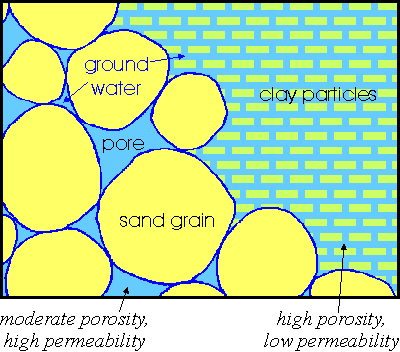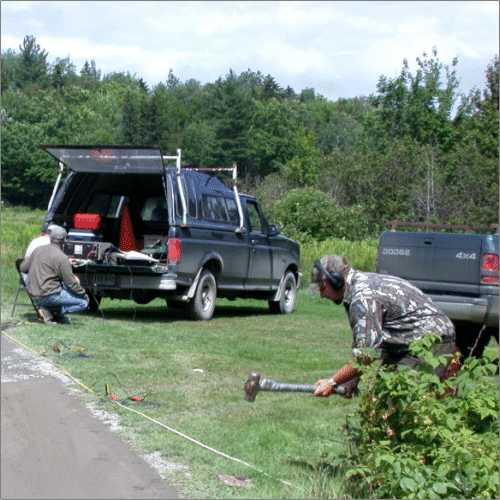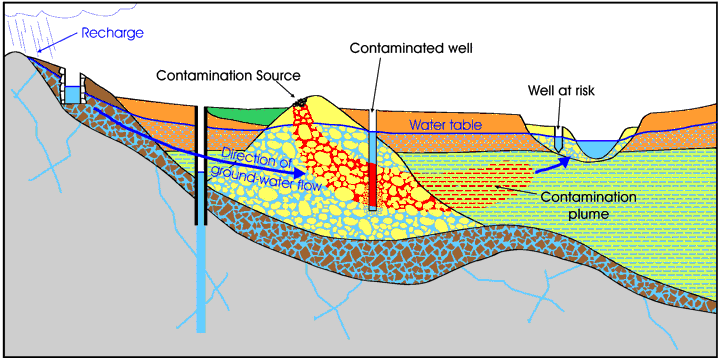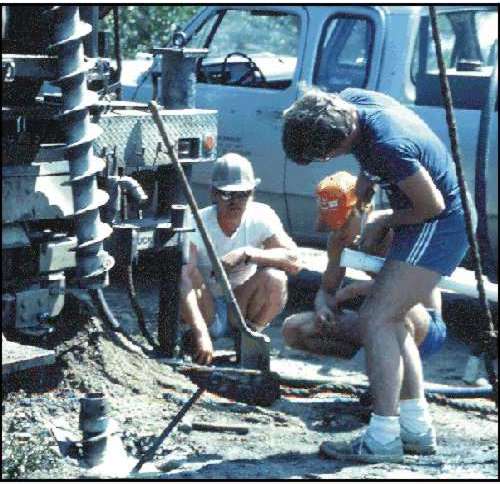DACF Home → Bureaus & Programs → Maine Geological Survey → Explore Maine Geology → Ground Water and Wells → Sand and Gravel Aquifers
Sand and Gravel Aquifers
What is an aquifer?
Ground water, as the name implies, is water found below the land surface in the pore spaces between sand grains and in fractures in the bedrock (see diagrams below). An aquifer is a water-bearing geologic formation capable of yielding a usable amount of ground water to a well. In Maine there are two types of aquifers; loose soil materials (such as sand, gravel, and other sediments) and fractured bedrock. A sand and gravel deposit is considered a significant aquifer when a well in that deposit is capable of being continuously pumped at a rate of 10 gallons per minute (gpm) or more. To sustain a yield of 10 gpm or more, a deposit must be permeable enough for water to flow readily into the well as it is pumped (see section on porosity and permeability below), and there must be a sufficient depth of water in the well so that it will not be pumped dry.
Several types of wells, common in Maine, are shown in Figure 1. A dug well is a large diameter hole excavated by hand or backhoe. The hole is kept from caving in by installing a lining that may be stone, tile, or cement blocks. The hole must be deep enough to extend below the water table. The shallow dug well in Figure 1 has a yield of 2 gpm. Although the yield is often low, dug wells generally supply enough ground water for a household because of the large amount of water stored in the well.

Figure 1. Schematic cross section of a sand and gravel aquifer in Maine. The blue line in the diagram is the water table. The area below the water table is called the saturated zone, where all pore spaces between the sediment particles are filled with water. In order to yield water, a well must extend below the water table into the saturated zone. Notice that the water table corresponds to the water level in most wells and in the stream. The blue box to the right of the gravel-packed well shows the area described in Figure 2.
A gravel-packed well is usually installed into coarse-grained sediment and is drilled with a much larger diameter than the final casing and screen diameter. To increase the yield and pumping efficiency of the well, the space around the well screen is filled with selected gravel that increases the permeability in the immediate vicinity of the well. The gravel-packed well in Figure 1 has a high yield of 300 gpm. Such high-yielding gravel-packed wells are commonly drilled for municipal or industrial water systems.
A driven well or well point can be installed into sand and gravel where the water table is within about 20 feet of the ground surface. A 2 to 3 inch diameter pipe, equipped with a well screen at its lower end, is driven into the deposit until the screen is below the water table. This pipe acts as a casing, and water is pumped directly from the aquifer. The driven well in Figure 1 has a significant yield of 15 gpm. Although the yield is relatively high, driven wells generally only supply a single household because very little water is stored in the well casing.
Wells of any type constructed in the other sediments shown in the diagram (clay or fine sand and silt) would yield some water, but yields would be lower than for wells in coarse-grained sand and gravel deposits.
Another type of well common in Maine is the drilled bedrock well. This well is drilled into the underlying rock with steel casing to isolate the well from potential surface-water contamination. In this type of well, water is found when the well hole intersects water-bearing fractures in the bedrock. Notice how the water level in this well is not the same level as the water table. The well casing isolates the bedrock well from the overlying sediments. The water level is controlled by water pressure in the fractures in the bedrock and is not related to the water table in the overlying materials.
Porosity and Permeability
Permeability is related to porosity, but is not the same. Porosity determines the capacity of the material to hold water. Permeability determines its ability to yield water. For example, clay is made of tiny particles with a large amount of pore space between them. However, the pore spaces are so small that they create a resistance to flow which reduces ground water permeability. Sand and gravel may not be as porous as clay, but the pore spaces are larger and better connected and the materials are much more permeable.
Permeability is an important characteristic since it determines whether ground water can actually be drawn into a pumping well.

Figure 2. An enlarged view of a section of Figure 1. Note that the section shown is below the water table and that ground water completely fills the pore spaces between the sediment grains. In an aquifer, the more pore space there is, the more water the aquifer can hold. This is called the porosity of a deposit. Permeability refers to the ability of a surficial deposit to transmit water. Permeability depends on the size of the spaces between the sediment grains.
How are aquifers mapped?
When mapping sand and gravel aquifers, geologists visit gravel pits, stream banks, road cuts, and other surface exposures to describe materials and identify deposits. This surficial geology mapping is supplemented with seismic-refraction studies and the installation of observation wells and test borings. In addition, much information about an aquifer may already be available from water-company exploration, large construction projects, town well inventories, and other sources. This information, along with aerial photography and previously published maps, allows the geologist to define the boundaries of favorable surficial deposits and estimate how well the deposits will yield water to a well.
The boundaries of favorable surficial deposits do not necessarily coincide with the aquifer boundaries. In some areas, a thin cover of favorable coarse-grained material may overlie fine-grained sediments, till, or bedrock. A well in that material would not be able to sustain a yield of 10 gpm, so the area would not be mapped as an aquifer. In other areas, fine-grained sediments or till may overlie favorable coarse-grained sediments and the subsurface deposit may not be recognized as an aquifer.
Single- and 12-channel seismic-refraction studies are conducted to determine the saturated thickness of a deposit by establishing the depth to water table and bedrock surface. The 12-channel seismic survey (Figure 3) has the additional advantage of providing the topography of the buried bedrock surface at a site.
Istalling monitoring wells and drilling test borings provide direct information about the aquifer characteristics of a deposit. This work provides information on the depth to water table and bedrock surface, water quality, and how easily the sediment transmits water.

Figure 3. Geologic technicians conducting a 12-channel seismic survey.
Ground-Water Flow and Contamination
Ground water is replenished or recharged by rainwater and melting snow that soak into the soil. This water percolates downward and eventually reaches the water table. When recharge is high during spring snowmelt and fall rains, the amount of ground water increases and the water table rises. When recharge is low during the late summer or when the ground is frozen during the winter, the water table becomes lower.
Notice in Figure 4 that ground water is not static; it flows. This concept is very important, especially when ground water becomes contaminated. Once in the ground-water system, contaminants usually travel along the paths followed by ground water and are sometimes able to migrate considerable distances over time.

Figure 4. A contamination plume (shown in red) originates at a source in the sand and gravel deposit. This source could be a landfill, a leaking fuel storage tank, or an accidental spill. As the contaminant seeps into the subsurface system and enters the aquifer, it flows with the ground water. The plume contaminated the gravel-packed well as it passed by. The driven well near the stream is not contaminated, but is at risk since the plume is flowing in that direction. The dug well on the hillside, however, is not affected because it is upgradient of the source, hence the contaminated ground water flows away from this well.
In Figure 4, a plume of contamination originates at the source in the sand and gravel deposit. This source could be a landfill, a leaking fuel storage tank, or an accidental spill. As the contaminant seeps into the subsurface system and enters the aquifer, it flows with the ground water. In Figure 4, the plume contaminated the gravel-packed well as it passed by. The driven well near the stream is not contaminated, but is at risk since the plume is flowing in that direction. The dug well on the hillside, however, is not affected because it is upgradient of the source, hence the contaminated ground water flows away from this well.
Once ground water is contaminated, it is very difficult and expensive to correct. To design a clean-up plan, monitoring wells (Figure 5) are installed under the direction of a hydrogeologist or other specialist. These wells define the three-dimensional extent of the affected area. Sometimes it is possible to pump contaminants to the surface using remediation wells within the plume. Often the only solution for a homeowner is to install filtering devices or to abandon the well and find an alternative water supply.

Figure 5. Installing a ground-water monitoring well.
Originally published as the sidebar for the Maine Geological Survey's Significant Aquifer Map series.
Last updated on October 6, 2005